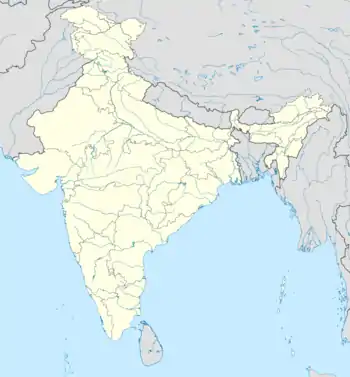Basti, Uttar Pradesh
Basti is a city and a municipal board in Basti district in the Indian state of Uttar Pradesh. Basti district is a part of Basti division. It is situated 202 kilometres east of state capital Lucknow.
Basti
Vaishishthi | |
|---|---|
City | |
 Basti Location in Uttar Pradesh, India  Basti Basti (India) | |
| Coordinates: 26.80°N 82.74°E | |
| Country | |
| State | Uttar Pradesh |
| District | Basti |
| Population (2011)[1] | |
| • Total | 114,657 |
| Language | |
| • Official | Hindi[2] |
| • Additional official | Urdu[2] |
| Time zone | UTC+5:30 (IST) |
| Vehicle registration | UP-51 |
| Website | www |
Basti was originally known as Vaishishthi.[3] The origin of the name Vaishishthi is attributed to the fact that this area was the ashram of Rishi (sage) Vashistha in ancient period. Rama with his younger brother Lakshmana had been here for some time with Rishi Vashistha.
The tract comprising the present district was remote and much of it was covered with forest. But gradually the area became inhabitable, for want of recorded and reliable history it cannot, with any degree of certainty, be said how the district came to be known by its present name on account of the original habitation (Basti) having been selected by the Kalhan Raja as a seat of his Raj, an event which probably occurred in the 16th century. In 1801, Basti became the Tehsil headquarters and in 1865 it was chosen as the headquarters of the newly established district.
In the freedom struggle of 1857, about 250 martyrs of Amorha state were hanged by the British Government from peepal trees located at Chhawani.[4][5][6][7]
Geography
The district lies between the parallels of 26° 23' and 27° 30' North and Latitude and 82° 17' and 83° 20' East longitude. Its maximum length from north to south is about 75 km. and breadth from east to west about 70 km. The district lies between newly created district Sant Kabir Nagar on the east and Gonda on the west. On the south, the Ghaghra river near Amorha Khas previously known as Amorha Province or State of Raja Zalim Singh separates it from the Faizabad and newly created district named Ambedkar Nagar. While on the north, it is bounded by district Sidharth Nagar.[8]
Demographics
As of 2011 Indian Census, Basti had a total population of 114,657, of which 60,095 were males and 54,562 were females. Population within the age group of 0 to 6 years was 13,349. The total number of literates in Basti was 84,389, which constituted 73.6% of the population with male literacy of 78.3% and female literacy of 68.5%. The effective literacy rate of 7+ population of Basti was 83.3%, of which male literacy rate was 88.6% and female literacy rate was 77.5%. The Scheduled Castes and Scheduled Tribes population was 17,036 and 275 respectively. Basti had 17894 households in 2011.[1]
As of the 2001 Census of India, Basti had a population of 27,50,764. Males constitute 52% of the population and females 48%. Basti has an average literacy rate of 90%, higher than the national average of 59.5%: male literacy is 93%, and female literacy is 87%. In Basti, 13% of the population are infants.[9]
Education
See also
References
- "Census of India: Basti". www.censusindia.gov.in. Retrieved 9 October 2019.
- "52nd Report of the Commissioner for Linguistic Minorities in India" (PDF). nclm.nic.in. Ministry of Minority Affairs. Archived from the original (PDF) on 25 May 2017. Retrieved 21 December 2018.
- "Where is Basti, Information about Basti, Where is Basti Located in Uttar Pradesh, India". Retrieved 28 October 2019.
- "Places of Interest". basti.nic.in. Archived from the original on 29 June 2016. Retrieved 9 June 2016.
- Thomas, D. (1998). Battles and Honours of the Royal Navy. Leo Cooper. p. 16. ISBN 9780850526233. Retrieved 14 January 2017.
- Benett, W.C. (1878). The final settlement report on the Gonda district. 23. p. 22. Retrieved 14 January 2017.
- Michael, B.A. (2014). Statemaking and Territory in South Asia: Lessons from the Anglo–Gorkha War (1814–1816). Anthem Press. p. 151. ISBN 9781783083220. Retrieved 14 January 2017.
- "Yahoo maps location of Basti". Yahoo maps. Retrieved 29 March 2009.
- "Census of India 2001: Data from the 2001 Census, including cities, villages and towns (Provisional)". Census Commission of India. Archived from the original on 16 June 2004. Retrieved 1 November 2008.